The direct fast dyes market's trajectory from USD 351.5 million in 2025 to USD 500.7 million by 2035 represents steady expansion, demonstrating accelerating adoption of specialized dyeing technologies and growing investment in textile manufacturing capabilities across apparel producers, printing facilities, and industrial dyeing operations worldwide.
The market operates within a dynamic landscape characterized by expanding textile production capacities, manufacturing modernization initiatives, and growing demand for color fastness across apparel manufacturing, industrial printing, and specialty textile applications. Market dynamics reflect increasing investment in textile processing infrastructure, accelerating adoption of advanced dyeing equipment, and rising demand for versatile coloring solutions that support diverse fabric types and production methodologies.
Textile manufacturing procurement patterns demonstrate shifting preferences toward high-performance dyeing systems that combine color intensity, wash fastness capabilities, and process efficiency features. Apparel manufacturers and printing facilities prioritize dye reliability, color consistency, and operational flexibility when selecting dyeing solutions for critical applications including fabric coloring, pattern printing, industrial textile processing, and specialty material treatment procedures.
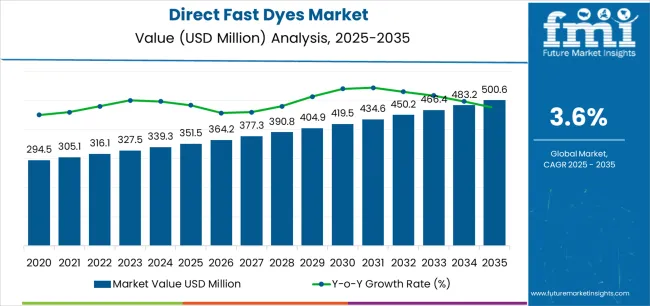
The market benefits from expanding textile production activities across fashion, industrial, and technical textile sectors, driving demand for sophisticated dyeing materials that enable complex coloring procedures. Growing emphasis on production efficiency and color standardization creates opportunities for manufacturers offering validated dyeing systems with comprehensive application documentation and quality control capabilities.
Technology advancement influences market evolution through integration of improved color formulations, enhanced fastness properties, and optimized application methods that improve manufacturing efficiency and dyeing outcomes. Manufacturers focus on developing dyeing solutions that accommodate varying fabric types, color specifications, and production parameters while maintaining consistent color performance throughout extended processing operations.
The direct fast dyes market demonstrates strong growth fundamentals driven by expanding textile activities, manufacturing infrastructure development, and increasing demand for reliable color solutions across multiple industrial applications and production environments.
The first half of the decade (2025-2030) will witness market growth from USD 351.5 million to approximately USD 408.2 million, adding USD 56.7 million in value, representing 38% of the total forecast period expansion. This phase will be characterized by rapid adoption of improved formulations, driven by textile modernization programs and increasing demand for efficient dyeing solutions across manufacturing applications.
The latter half (2030-2035) will experience accelerated growth from USD 408.2 million to USD 500.7 million, representing an addition of USD 92.5 million or 62% of the decade's expansion. This period will be defined by mass market penetration of advanced direct fast dye technologies, integration with automated dyeing systems, and seamless connectivity with existing textile production infrastructure.
| Period | Primary Revenue Buckets | Share | Notes |
|---|---|---|---|
| Today | Yellow dyes (textile, printing) | 42% | Traditional applications, established facilities |
| Red and blue systems | 31% | Standard coloring, specialized applications | |
| Black and other formulations | 27% | Premium installations, specialized dyeing | |
| Future (3-5 yrs) | Advanced yellow systems | 38-41% | Enhanced performance, improved fastness |
| High-performance red/blue systems | 28-32% | Industrial complexes, production facilities | |
| Textile applications | 62-68% | Fabric dyeing, apparel manufacturing | |
| Printing applications | 25-32% | Pattern printing, industrial printing | |
| Other applications | 8-15% | Technical textiles, specialty materials | |
| Specialized formulations | 6-12% | Custom dyeing, industrial processing |
| Metric | Value |
|---|---|
| Market Value (2025) | USD 351.5 million |
| Market Forecast (2035) | USD 500.7 million |
| Growth Rate | 3.6% CAGR |
| Leading Color | Yellow Dyes |
| Primary Application | Textile Segment |
The market demonstrates strong fundamentals with yellow dye formulations capturing dominant share through proven color performance and textile application optimization. Textile applications drive primary demand, supported by increasing manufacturing activity and production facility expansion initiatives. Geographic distribution remains concentrated in developed markets with established textile infrastructure, while emerging economies show accelerating adoption rates driven by industrial modernization programs and rising manufacturing investment.
Primary Classification: The market segments by color into yellow, red, blue, black, and other formulations, representing evolution from traditional dyeing to sophisticated color-fast technologies for comprehensive textile manufacturing optimization.
Secondary Classification: Application segmentation divides the market into textile, printing, and other applications, reflecting distinct requirements for color specifications, fastness properties, and production process parameters.
Tertiary Classification: End-use segmentation covers apparel manufacturers, printing facilities, industrial textile producers, technical textile companies, and specialty dyeing operations, while distribution channels span direct sales, chemical distributors, and specialized textile chemical suppliers.
Regional Classification: Geographic distribution covers North America, Latin America, Western Europe, Eastern Europe, East Asia, South Asia Pacific, and Middle East & Africa, with developed markets leading adoption while emerging economies show accelerating growth patterns driven by textile manufacturing development programs.
The segmentation structure reveals technology progression from traditional dyeing toward sophisticated color-fast systems with enhanced performance capabilities, while application diversity spans from basic textile coloring to specialized industrial dyeing procedures requiring precise color control solutions.
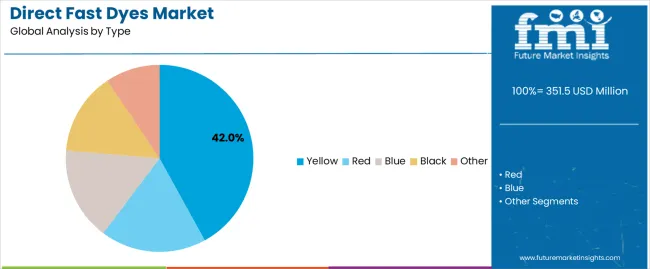
Market Position: Yellow direct fast dye formulations command the leading position in the direct fast dyes market with 42% market share through proven color performance technologies, including efficient dye uptake, reliable color fastness, and textile processing optimization that enable manufacturing operators to achieve optimal coloring results across diverse textile and printing environments.
Value Drivers: The segment benefits from textile facility preference for versatile dyeing formulations that provide consistent color reproduction, processing reliability, and application flexibility without requiring extensive process modifications. Advanced yellow processing features enable enhanced color uniformity, precise shade control, and integration with existing dyeing systems, where color consistency and process reliability represent critical operational requirements.
Competitive Advantages: Yellow direct fast dye formulations differentiate through proven operational performance, broad application compatibility, and integration with established textile processing systems that enhance manufacturing effectiveness while maintaining optimal color standards suitable for diverse production applications.
Key market characteristics:
Red and blue direct fast dye formulations maintain combined 31% market position in the direct fast dyes market due to their specialized color characteristics and diverse application benefits. These formulations appeal to facilities requiring specific color ranges with enhanced fastness profiles for production-scale operations. Market growth is driven by apparel facility expansion, emphasizing color diversity solutions and operational excellence through optimized dyeing performance designs.
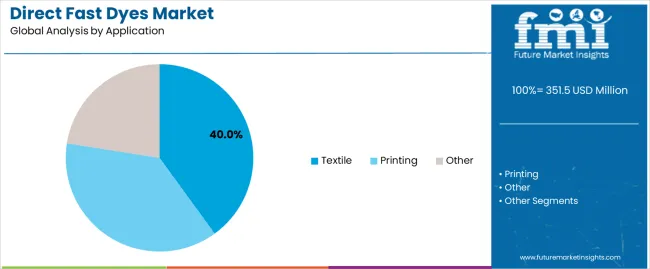
Market Context: Textile applications demonstrate strong growth in the direct fast dyes market with 40% share due to widespread adoption of fabric dyeing technologies and increasing focus on apparel manufacturing, industrial textile production, and specialty fabric applications that maximize color effectiveness while maintaining textile quality standards.
Appeal Factors: Textile manufacturers prioritize dye reliability, color fastness, and integration with existing production infrastructure that enables coordinated dyeing procedures across multiple fabric types. The segment benefits from substantial apparel industry investment and textile development programs that emphasize acquisition of advanced dyeing systems for fabric optimization and manufacturing applications.
Growth Drivers: Apparel manufacturing programs incorporate direct fast dyes as essential components for fabric coloring operations, while industrial textile production increases demand for dyeing capabilities that comply with quality standards and minimize color variation.
Market Challenges: Varying fabric types and color complexity may limit formulation standardization across different manufacturing facilities or production scenarios.
Application dynamics include:
Printing applications capture 28% market share through pattern printing requirements in textile facilities, industrial printing operations, and specialty printing applications. These facilities demand high-performance dyeing formulations capable of supporting printing protocols while providing color precision and operational reliability capabilities.
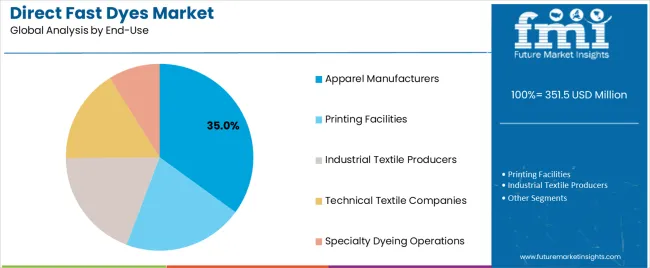
Market Context: Apparel Manufacturers dominate the market with 35% share, reflecting the primary demand source for direct fast dye technology in fabric processing and color optimization.
Business Model Advantages: Apparel Manufacturers provide direct market demand for standardized dyeing formulations, driving volume production and cost optimization while maintaining color performance and fastness consistency requirements.
Operational Benefits: Apparel Manufacturer applications include production optimization, manufacturing efficiency, and quality assurance that drive consistent demand for dyeing formulations while providing access to latest direct fast dye technologies.
| Category | Factor | Impact | Why It Matters |
|---|---|---|---|
| Driver | Textile manufacturing expansion & production modernization (apparel industry growth, facility upgrades) | ★★★★★ | Growing textile market requires advanced dyeing systems with enhanced color fastness capabilities and performance properties proven effective across manufacturing applications. |
| Driver | Fashion industry advancement & apparel development (design innovation, color requirements) | ★★★★★ | Transforms dyeing requirements from "basic coloring" to "precision color performance"; operators that offer advanced dyeing formulations and fastness features gain competitive advantage. |
| Driver | Production automation & process optimization (workflow integration, quality control) | ★★★★☆ | Modern textile facilities need sophisticated, reliable dyeing systems; demand for automated and integrated production solutions expanding addressable market. |
| Restraint | Raw material cost fluctuations & supply constraints (especially for chemical intermediates) | ★★★★☆ | Smaller textile facilities defer dyeing system upgrades; increases price sensitivity and slows advanced formulation adoption in cost-conscious markets. |
| Restraint | Alternative dyeing technology competition (reactive dyes, disperse dyes) | ★★★☆☆ | Traditional dyeing alternatives offer established supply chains and process familiarity, potentially limiting direct fast dye adoption in conventional applications. |
| Trend | Formulation improvement & performance enhancement (color fastness, application efficiency) | ★★★★★ | Advanced color properties, fastness optimization, and application efficiency transform operations; formulation improvement and performance enhancement become core value propositions. |
| Trend | Process integration & quality control (automated application, color monitoring systems) | ★★★★☆ | Smart dyeing systems for specific applications and processes; specialized monitoring and targeted optimization capabilities drive competition toward integrated solutions. |
The direct fast dyes market demonstrates varied regional dynamics with Growth Leaders including China (4.9% growth rate) and India (4.5% growth rate) driving expansion through textile manufacturing development and production modernization initiatives. Steady Performers encompass Germany (4.1% growth rate), Brazil (3.8% growth rate), and developed regions, benefiting from established textile facilities and apparel sector growth. Mature Markets feature United States (3.4% growth rate), United Kingdom (3.1% growth rate), and Japan (2.7% growth rate), where manufacturing advancement and production optimization requirements support consistent growth patterns.
Regional synthesis reveals East Asian markets leading adoption through textile expansion and manufacturing development, while North American countries maintain steady expansion supported by apparel industry advancement and production infrastructure investment. European markets show strong growth driven by textile applications and manufacturing integration trends.
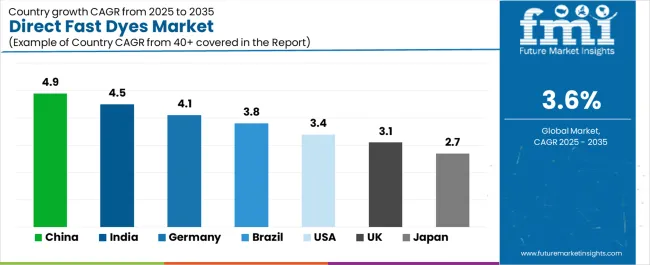
| Region/Country | 2025-2035 Growth | How to win | What to watch out |
|---|---|---|---|
| China | 4.9% | Focus on cost-effective dyeing solutions | Regulatory changes; local competition |
| India | 4.5% | Lead with color fastness systems | Export restrictions; infrastructure barriers |
| Germany | 4.1% | Provide premium textile systems | Over-regulation; lengthy approvals |
| Brazil | 3.8% | Offer value-oriented solutions | Currency fluctuations; import duties |
| United States | 3.4% | Push technology integration | Compliance costs; scaling challenges |
| United Kingdom | 3.1% | Focus on textile applications | Economic impacts; supply constraints |
| Japan | 2.7% | Emphasize precision manufacturing | Traditional preferences; adoption rates |
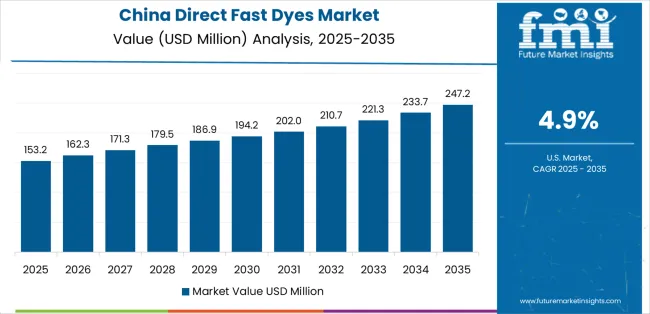
China establishes fastest market growth through aggressive textile manufacturing development programs and comprehensive production facility expansion, integrating advanced direct fast dye systems as standard components in apparel factories and textile production facilities. The country's 4.9% growth rate reflects government initiatives promoting manufacturing infrastructure and domestic textile capabilities that mandate use of color-fast dyeing systems in apparel and industrial textile production facilities. Growth concentrates in major textile hubs, including Jiangsu, Zhejiang, and Guangdong, where manufacturing development showcases integrated dyeing systems that appeal to textile operators seeking color performance capabilities and production applications.
Chinese manufacturers are developing cost-effective dyeing formulations that combine domestic production advantages with advanced color-fast features, including enhanced fastness properties and improved application capabilities. Distribution channels through chemical suppliers and textile facility integrators expand market access, while government support for manufacturing development supports adoption across diverse apparel and textile segments.
Strategic Market Indicators:
In Mumbai, Delhi, and Ahmedabad, textile facilities and apparel operators are implementing direct fast dye systems as standard materials for production optimization and manufacturing efficiency applications, driven by increasing government industrial investment and textile development programs that emphasize importance of color performance capabilities. The market holds a 4.5% growth rate, supported by government manufacturing initiatives and industrial modernization programs that promote advanced dyeing systems for textile and apparel facilities. Indian operators are adopting dyeing formulations that provide consistent color fastness and performance features, particularly appealing in urban regions where production optimization and color excellence represent critical manufacturing requirements.
Market expansion benefits from growing textile capabilities and international technology partnerships that enable domestic production of advanced dyeing systems for apparel and industrial applications. Technology adoption follows patterns established in chemical processing, where performance and reliability drive procurement decisions and operational deployment.
Market Intelligence Brief:
Germany maintains its leadership in the direct fast dyes market through its robust engineering culture and advanced chemical technologies. Known for its high-quality manufacturing and compliance with EU standards, Germany's 4.1% growth rate reflects the country’s ongoing investment in premium dyeing solutions, particularly for industrial applications and apparel. Manufacturing centers in Bavaria, Baden-Württemberg, and North Rhine-Westphalia are key drivers of this growth, as these regions integrate advanced dyeing systems into existing production frameworks.
The demand for direct fast dyes in Germany is characterized by a preference for quality and precision. Textile manufacturers are focused on optimizing dyeing systems to meet rigorous color compliance standards, with an emphasis on advanced formulations and system integration. Companies are increasingly collaborating with international suppliers to integrate high-performance dyeing technologies that meet stringent environmental and regulatory standards. This demand for high-quality solutions continues to fuel the market’s growth trajectory, as businesses prioritize sustainability and operational efficiency.
Market Intelligence Brief:
Direct fast dyes sector in Brazil is expanding due to the growing demand for textile products, particularly in São Paulo and Rio de Janeiro. The 3.8% growth rate is driven by increasing industrial activity and government initiatives focused on modernizing textile infrastructure. As Brazil’s textile industry undergoes significant transformation, demand for advanced dyeing systems capable of delivering consistent color fastness and high-quality production output is rising.
On the supply side, Brazil is focusing on cost-effective dyeing formulations that balance performance with affordability. This is particularly important in the context of growing manufacturing activity and increasing demand for high-quality apparel and textiles. Local producers are also enhancing their production capabilities by partnering with international chemical suppliers to adopt advanced dyeing technologies that help improve color precision and meet export requirements. With government initiatives supporting industrial growth, Brazil is positioning itself as a regional leader in textile manufacturing and dyeing technologies.
Strategic Market Considerations:
United States establishes market leadership through comprehensive textile programs and advanced apparel infrastructure development, integrating direct fast dye systems across manufacturing and industrial applications. The country's 3.4% growth rate reflects established textile relationships and mature chemical technology adoption that supports widespread use of color-fast dyeing systems in apparel and industrial facilities. Growth concentrates in major textile centers, including North Carolina, Georgia, and South Carolina, where chemical technology showcases mature deployment that appeals to textile operators seeking proven color capabilities and production optimization applications.
American textile providers leverage established distribution networks and comprehensive technical support capabilities, including formulation design programs and training support that create customer relationships and operational advantages. The market benefits from mature regulatory standards and manufacturing requirements that mandate dyeing system use while supporting technology advancement and production optimization.
Market Intelligence Brief:
United Kingdom's textile market demonstrates integrated direct fast dye deployment with documented color effectiveness in apparel applications and manufacturing facilities through integration with existing production systems and industrial infrastructure. The country maintains a 3.1% growth rate, supported by manufacturing efficiency programs and color effectiveness requirements that promote color-fast dyeing systems for textile applications. Manufacturing facilities across England, Scotland, and Wales showcase systematic installations where dyeing systems integrate with comprehensive production platforms to optimize color performance and manufacturing outcomes.
UK textile providers prioritize formulation reliability and production compatibility in dyeing procurement, creating demand for validated systems with proven color features, including performance monitoring integration and quality management systems. The market benefits from established manufacturing infrastructure and quality requirements that support chemical technology adoption and color effectiveness.
Market Intelligence Brief:
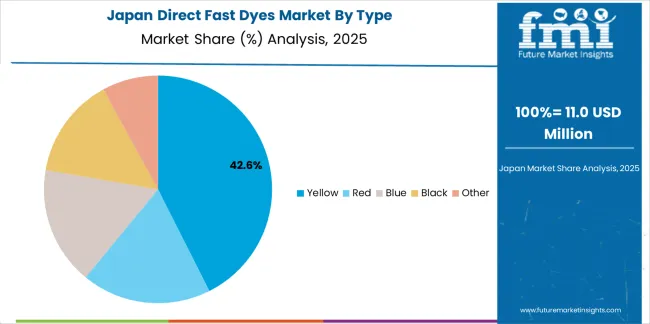
Direct fast dyes market in Japan is expanding steadily, with a focus on precision in textile manufacturing. The 2.7% growth rate is driven by the country’s high standards for color fastness and its demand for advanced dyeing technologies. Japan’s textile facilities, particularly in Tokyo and Osaka, are adopting high-precision dyeing systems that ensure accurate color control and high-quality production outcomes. The emphasis on quality and efficiency in the textile industry continues to make Japan a key player in the global dyeing solutions market.
Japanese manufacturers are focusing on integrating advanced dyeing systems into their production lines to meet stringent color requirements and operational efficiency standards. There is a strong preference for systems that offer precision, enhanced color consistency, and sustainable production capabilities. As Japan continues to advance its textile manufacturing technologies, the demand for direct fast dyes remains high, driven by the need for high-performance, reliable solutions that align with international standards.
Strategic Market Considerations:
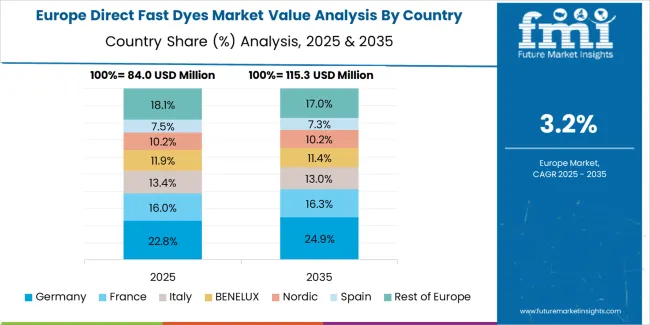
The European direct fast dyes market is projected to grow from USD 67.2 million in 2025 to USD 95.8 million by 2035, registering a CAGR of 3.6% over the forecast period. Germany is expected to maintain its leadership position with a 45.3% market share in 2025, supported by its advanced textile infrastructure and major manufacturing centers.
United Kingdom follows with a 26.8% share in 2025, driven by comprehensive apparel programs and textile development initiatives. France holds a 14.2% share through specialized manufacturing applications and textile compliance requirements. Italy commands a 8.1% share, while Spain accounts for 5.6% in 2025. The rest of Europe region is anticipated to gain momentum, expanding its collective share from 2.4% to 2.7% by 2035, attributed to increasing textile adoption in Nordic countries and emerging manufacturing facilities implementing production modernization programs.
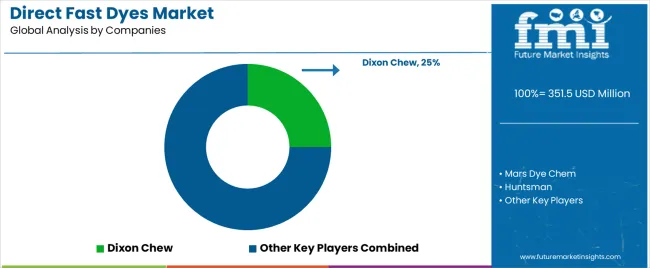
| Stakeholder | What they actually control | Typical strengths | Typical blind spots |
|---|---|---|---|
| Global brands | Distribution reach, broad product catalogs, brand recognition | Wide availability, proven color performance, multi-region support | Product refresh cycles; customer dependency on brand validation |
| Technology innovators | Formulation R&D; advanced color technologies; enhanced fastness properties | Latest technologies first; attractive ROI on color effectiveness | Service density outside core regions; scaling complexity |
| Regional specialists | Local compliance, fast delivery, nearby customer support | "Close to customer" support; pragmatic pricing; local regulations | Technology gaps; talent retention in customer service |
| Full-service providers | Complete textile programs, system integration, performance monitoring | Lowest operational risk; comprehensive support | Service costs if overpromised; technology obsolescence |
| Niche specialists | Specialized applications, custom formulations, technical services | Win premium applications; flexible configurations | Scalability limitations; narrow market focus |
| Item | Value |
|---|---|
| Quantitative Units | USD 351.5 million |
| Color | Yellow, Red, Blue, Black, Other |
| Application | Textile, Printing, Other |
| End Use | Apparel Manufacturers, Printing Facilities, Industrial Textile Producers, Technical Textile Companies, Specialty Dyeing Operations |
| Regions Covered | North America, Latin America, Western Europe, Eastern Europe, East Asia, South Asia Pacific, Middle East & Africa |
| Countries Covered | China, India, Germany, Brazil, United States, United Kingdom, Japan, Canada, France, Australia, and 25+ additional countries |
| Key Companies Profiled | Dixon Chew, Mars Dye Chem, Huntsman, Everlight Chemical, Aljo Dyes, Vipul Organics, Zhejiang Runtu, Tianjin Xiangrui Dyestuff, Zhejiang Jihua |
| Additional Attributes | Dollar sales by color and application categories, regional adoption trends across East Asia, South Asia Pacific, and Western Europe, competitive landscape with chemical manufacturers and system integrators, textile operator preferences for color effectiveness and fastness control, integration with production platforms and quality management systems, innovations in dyeing technology and color enhancement, and development of advanced dyeing solutions with enhanced performance and manufacturing optimization capabilities. |
The global direct fast dyes market is estimated to be valued at USD 351.5 million in 2025.
The market size for the direct fast dyes market is projected to reach USD 500.6 million by 2035.
The direct fast dyes market is expected to grow at a 3.6% CAGR between 2025 and 2035.
The key product types in direct fast dyes market are yellow, red, blue, black and other.
In terms of application, textile segment to command 40.0% share in the direct fast dyes market in 2025.






Full Research Suite comprises of:
Market outlook & trends analysis
Interviews & case studies
Strategic recommendations
Vendor profiles & capabilities analysis
5-year forecasts
8 regions and 60+ country-level data splits
Market segment data splits
12 months of continuous data updates
DELIVERED AS:
PDF EXCEL ONLINE
Direct Thermal Printing Film Market Size and Share Forecast Outlook 2025 to 2035
Directional Drilling Service Market Forecast Outlook 2025 to 2035
Direct Methanol Fuel Cell Market Size and Share Forecast Outlook 2025 to 2035
Direct Operated Poppet Valve Market Forecast and Outlook 2025 to 2035
Direct to Garment Printing Market Size and Share Forecast Outlook 2025 to 2035
Direct Burial Fiber Optic Cable Market Size and Share Forecast Outlook 2025 to 2035
Directed Energy Weapons Market Size and Share Forecast Outlook 2025 to 2035
Direct To Chip Liquid Cooling Market Size and Share Forecast Outlook 2025 to 2035
Direct Write Semiconductor Market Size and Share Forecast Outlook 2025 to 2035
Direct Oral Anticoagulants Market Size and Share Forecast Outlook 2025 to 2035
Direct Thermal Linerless Labels Market Size and Share Forecast Outlook 2025 to 2035
Direct Thermal Inks & Coating Market from 2025 to 2035
Direct-to-Shape Inkjet Printer Market Size, Growth, and Forecast 2025 to 2035
Directed Energy-Based Surgical Systems Market Growth – Forecast 2025 to 2035
Direct-to-Consumer Genetic Testing Market Analysis - Trends & Outlook 2025 to 2035
Assessing Direct-to-shape Inkjet Printer Market Share & Industry Trends
Market Share Insights of Leading Direct Thermal Printing Film Providers
Evaluating Direct to Garment Printing Market Share & Provider Insights
Market Share Distribution Among Direct Thermal Inks & Coating Manufacturers
Market Share Insights of Direct Thermal Linerless Providers

Thank you!
You will receive an email from our Business Development Manager. Please be sure to check your SPAM/JUNK folder too.
Chat With
MaRIA